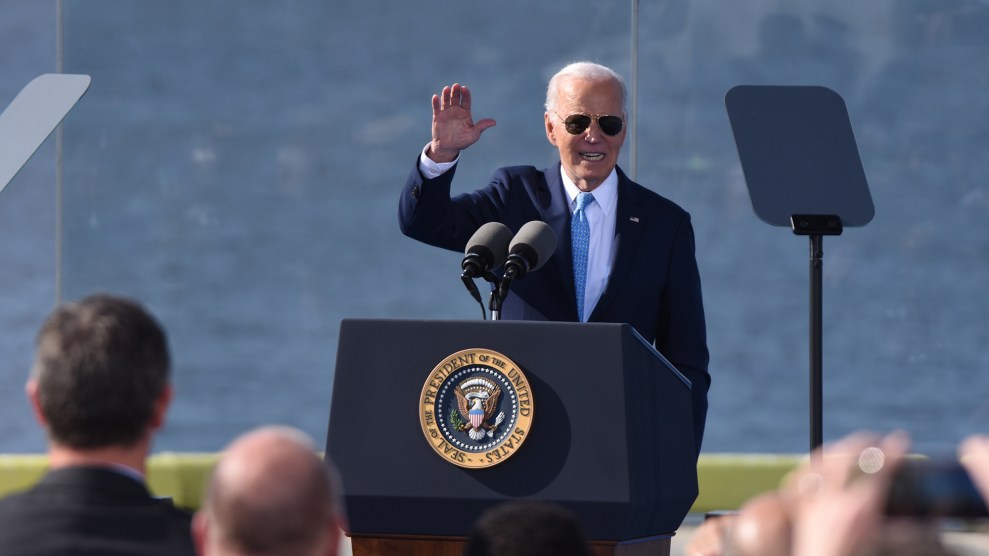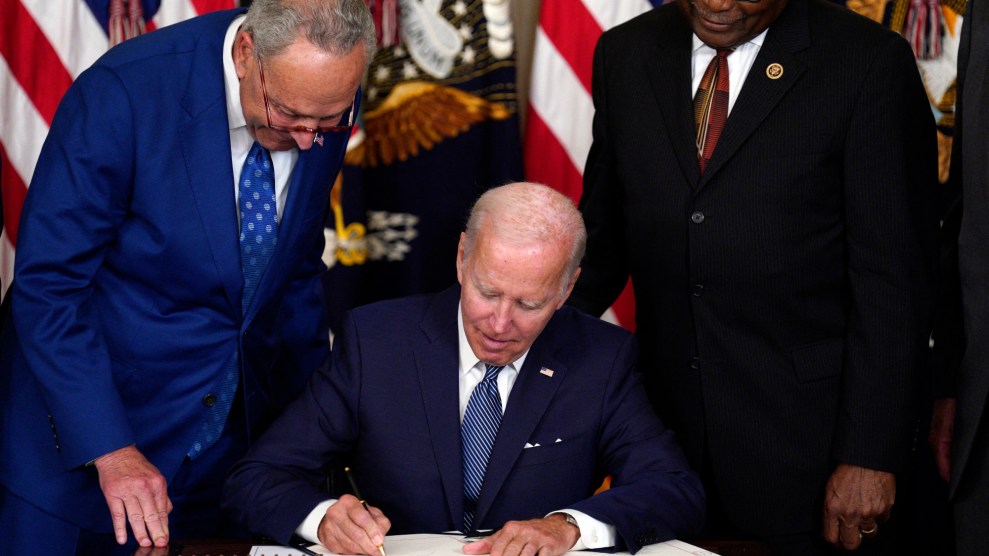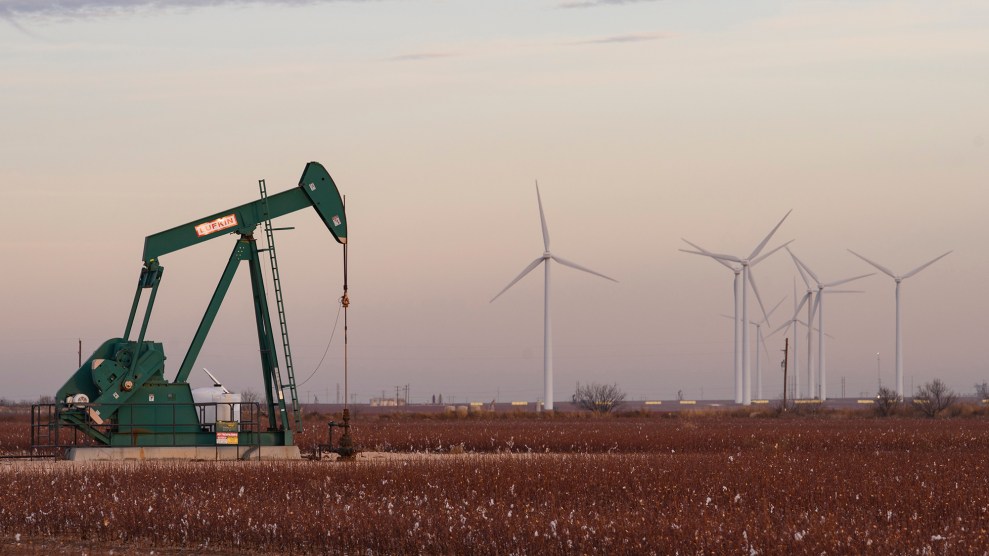
President Joe Biden delivers remarks announcing investments through the Inflation Reduction Act to make port infrastructure improvements and create union jobs at the Port of Baltimore.
This story was originally published by Vox.com and is reproduced here as part of the Climate Desk collaboration.
The 2022 Inflation Reduction Act stands as the single largest piece of legislation to address climate change in United States history.
The IRA contains nearly $370 billion for programs like tax credits for more efficient appliances, building new battery plants, and subsidies for renewable energy. And it triggered a boom in new construction and manufacturing for things like solar panels. It also created hundreds of thousands of new jobs.
But two years later, much of that money remains unspent.
The largest investment—ever— for the clean energy transition has yet to materialize into actual hardware like heat pumps or wind turbines. Despite more than $7.5 billion allocated to building electric vehicle chargers, for example, only a handful have been built. About 40 percent of big IRA projects hit delays, according to the Financial Times.
There were a lot of factors behind Democrats’ loss of the White House, but one particular source of frustration for the White House was that President Joe Biden received little credit for IRA spending, much of which was targeted at Republican-led districts and was structured to meet the goals of environmental activists, like prioritizing disadvantaged communities. The slow rollout is part of why the IRA barely registered with voters, even among those concerned about climate change.
“We always have this trade-off between how many safeguards we want to have to prevent misuse of money and how insistent we are on the other hand to get money out in a way that stimulates economic growth.”
Now President-elect Donald Trump has said he wants to claw back the unspent money and congressional Democrats are getting antsy. In a recent letter, dozens of senators and representatives wrote to the White House asking Biden to get more money out the door, from the IRA as well as other legislation like the Bipartisan Infrastructure Law.
“[T]here are so many more good projects, good jobs, and good savings to unleash,” they wrote. “To avoid future politicization or manipulation of climate programs, we ask that your agencies move expeditiously to disburse key climate and clean energy programs.”
The White House in turn is rushing to get programs like clean energy loan guarantees out the door. Some households are also scrambling to take advantage of incentives for heat pumps, home weatherization, and energy-efficient appliances before the new administration takes office.
All of this shows that despite the political will and time pressure, spending money can actually be pretty hard. Many state and local governments are finding that federal funds come with more strings attached than they anticipated. Ordinary people meanwhile are running into obstacles such as paperwork and supply chain snarls as they try to take advantage of tax credits and discounts.
In the waning days of the Biden administration, the White House could still step up its climate investments, but the question is whether they can go to work in time, and whether the next president can roll them back.
One of the big challenges with spending most federal funds in programs like the IRA is that the money doesn’t go straight to suppliers for construction materials, EV chargers, batteries, or home insulation. Rather, the funds are sent to state and local authorities who then distribute the money.
That added step creates a lot of complications. First, a lot of local officials simply are not set up to receive a lot of cash all at once. It requires rigorous accounting and record-keeping, so before they can use the money, recipients have to invest in the personnel and tools to track it. Then when money hits bank accounts, local officials have to decide where to spend it. That means seeking out proposals, soliciting competitive bids, and giving enough time for communities to weigh in. Even for “shovel-ready” projects, they often have to contend with last-minute hurdles like rising financing costs from inflation, supply chain snarls, and litigation that can halt ground-breaking.
Local governments also have their own incentives. While Biden’s White House wanted to juice the clean energy economy as fast as possible, often state and local governments want to stretch out the funds. “There’s always a sense that if money is spent too quickly, people might get used to the money, maybe even addicted to it, and then officials would have to raise taxes to make up the difference” when it runs out, said Donald Kettl, professor emeritus at the University of Maryland School of Public Policy who studies government spending.
Delays also result from how the funding is leveraged, whether it’s a grant, a loan, a loan guarantee, or a tax credit. Tax credits add an inherent lag because you don’t receive the cash benefit until you file your taxes.
There have been some counterexamples, though. Many of the Covid-19 pandemic spending measures like the Paycheck Protection Program did get money into people’s hands quickly. Those programs were relatively simple to administer. The stimulus checks automatically went out to people based on their tax records, for example, but the programs also didn’t have strong guardrails, leading to malfeasance and fraud. Billions of dollars in the PPP went to companies owned by celebrities and was spent on hotels, jewelry, and luxury cars.
“We always have this trade-off between how many safeguards we want to have to prevent misuse of money and how insistent we are on the other hand to get money out in a way that stimulates economic growth,” Kettl said. “Every time we do something like this, we tend to set that balance at a different spot.”
For ordinary people, getting IRA funds has also proven challenging. Many would-be EV buyers, for example, have been frustrated by dealers who don’t know about all the tax credits and discounts that can shave down the sticker price. Often, it’s the buyers educating sellers about the sweeteners. Homeowners have also struggled to find installers for heat pumps. Production declines and shipping delays have made it harder to buy more energy-efficient appliances.
There are also factors beyond Biden’s direct control at play. Changes in global demand and uncertainty about the outcome of the presidential election led some companies to hold off on executing IRA-funded projects. And those that do want to get rolling often have to go through a tedious, sometimes years-long permitting process before they can break ground.
Trump has never had a favorable outlook on clean technology and wants to cut spending and “waste” across the government. Even Trump’s pick to run the new Department of Government Efficiency, Elon Musk, who is also the CEO of one of the largest electric vehicle companies, has said he’s in favor of rolling back EV tax credits. But Trump may not be able to do much to recall any money already spent and prevent money that’s been appropriated from going out the door. The fact remains that Congress is mainly in charge of spending money and it would take another act of Congress to undo the IRA.
Trump and his allies, however, have floated the idea that the president has the authority to impound funding. It’s a legally questionable mechanism by which the president could stop money that’s already approved by Congress from being spent in the future.
“The courts have largely been on the side of Congress on that. Whether or not the courts would be more favorable this time is anybody’s guess.”
“The courts have largely been on the side of Congress on that,” Kettl said. “Whether or not the courts would be more favorable this time is anybody’s guess.”
Any changes to tax credits likely won’t take effect in the current tax cycle and will have to go through the budgeting process. It’s worth noting that Trump extended tax credits for renewables, energy efficiency, and carbon capture during his first term.
Trump could slow-walk the remaining funding, and if his second turn in office is anywhere near as chaotic as the first, it may not even be a deliberate choice. But he may pay a political price for cutting back on clean energy funding. Though Biden and Vice President Kamala Harris didn’t reap many benefits from laws like the IRA at the ballot box, they will likely get harder to reverse as the programs mature.
“The political logic was sound but the rollout was too rushed for the various programs to reap electoral benefits so soon,” Steven Vanderheiden, who studies environmental politics at the University of Colorado, wrote in an email. “While I think that the Biden team could have done a better job in communicating the value of these efforts, ultimately I think that there was just not enough time for them to become a real game-changer in the recent election.”
When Trump takes office, IRA investments will only get more entrenched.
Republicans may remain ideologically opposed to such programs, but about 60 percent of the resulting jobs are in districts whose representatives voted against it. About 80 percent of the investments are in Republican-led states. The political uncertainties that deterred clean energy spending prior to the election have now been resolved, and there may be appetite for more projects.
So while Trump may try to cut off any more new money from the IRA, it’s only going to get harder to stop what’s already underway.
















